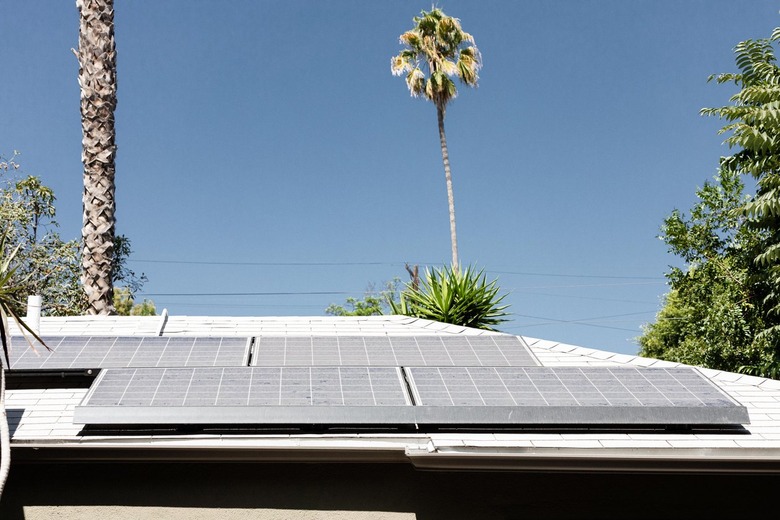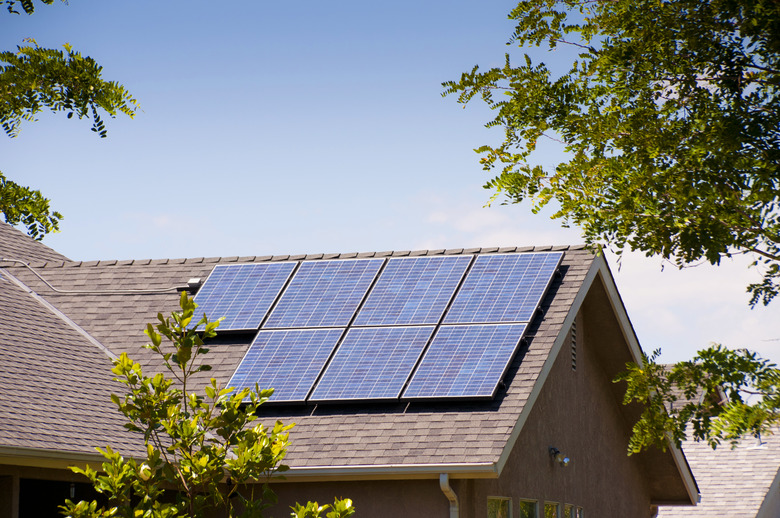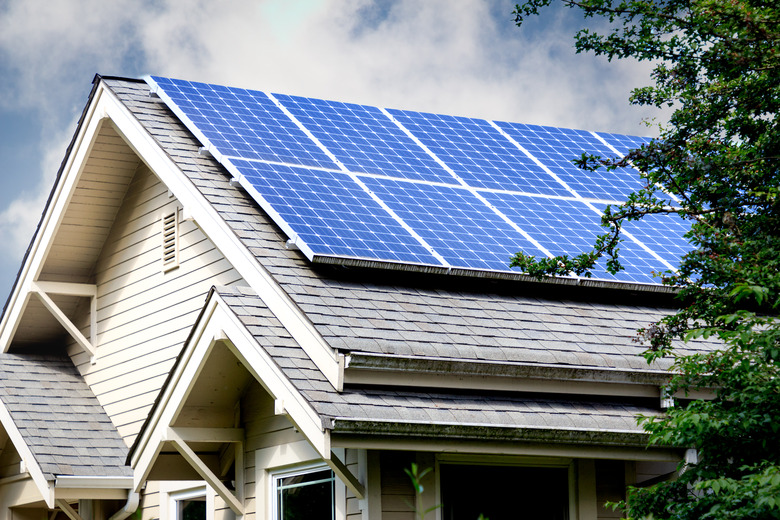What Does Solar Panel Installation Cost? (And How To Hire For The Job)
We may receive a commission on purchases made from links.
Whether you're interested in lowering your electric bill, reducing your carbon footprint, or both, there's good news for homeowners: Installation costs for a residential solar panel system have been steadily declining over the years. Despite that, solar isn't necessarily for everyone. The practicality of a solar installation depends primarily on the amount of sunlight you get as well as the cost of electricity, both of which vary by location.
The most common type of solar installation involves a "grid-tied" system that connects to the utility grid and has the potential to run your electric meter backward (when you're generating more electricity that you're using). There are many other options for solar power, including small generating stations for charging electric vehicles or solar well pump systems that ensure you have water even during a power outage. There are also "off-grid" home systems that do not connect to the utility as well as hybrid setups that can disconnect from the grid to operate in off-grid mode during power outages.
For most consumers, the biggest question about solar home power is whether the energy savings will offset the installation costs and how long it will take for that to happen. Answering that question is one of the jobs of a solar installation contractor, and if you decide to go for it, the contractor will help you configure the system. Finally, the contractor installs the panels and equipment you need so you can start saving on your energy bills as soon as the system comes online.
Tip
The installation costs for home solar energy systems has dropped 20 percent since 2016. As of 2021, the national average cost is $2.76 per watt before deducting the 26-percent federal solar tax credit (available through 2022). The average gross cost for a 10 kilowatt system is $26,700, which reduces to $20,424 after the federal tax credit. Other rebates and tax incentives may further reduce costs.
A Guide to Solar Installation Costs
A Guide to Solar Installation Costs
The installation costs for a solar panel system include the cost of the panels, auxiliary equipment (such as inverters and batteries), and labor. Most homeowners can expect to receive tax credits, rebates, and incentives to reduce costs.
Panels
The cost of solar panels is typically quoted on a per-watt basis. For a few examples, SunPower and Hyundai panels are at the high end and cost $3.35 and $3.03 per watt, respectively, while VSUN and Risen panels at the low end cost $2.11 and $2.40, respectively. As with any consumer product, you get what you pay for, meaning the cheapest panels are probably not the best in terms of efficiency and longevity.
Homeowners also have the option of installing solar shingles, which can be a cost-effective way to take advantage of the need for a roof replacement. Tesla's Solar Roof is one of the most popular products, but prices have risen in 2021 to be about 50 percent higher than they were previously. A 2,000-square-foot solar roof, which can generate over 12 kilowatts (kW) of electricity, costs almost $65,000, according to Forbes. That's about $37.50 per square foot. There are several other brands of solar shingles that are considerably less expensive.
System Size
System size also factors into the per-watt cost of a solar installation, with larger systems obviously costing more than smaller ones but less per watt. For example, the average cost of the panels for a 4 kW solar panel system before rebates and incentives are applied is $11,524 ($2.88 per watt), while that for a 10 kW system is $27,541 ($2.75 per watt). The federal solar investment tax credit (ITC) reduces those costs by 26 percent to $8,528 and $20,380, respectively.
Inverters
Inverters are essential equipment — they are what turn direct current (DC) electricity to alternating current (AC) electricity in your home — and depending on the system design, you may choose to install microinverters, which are used with every one or two solar panels and start at about $150 each, or you can install a string inverter, which services all the panels at once. Most string inverter systems need only one string inverter, which costs about $1,500 and up. String inverter systems can benefit from the addition of power optimizers, an option that may be offered as an upgrade. Both inverter types have their pros and cons, and deciding which type is best for your system is an important discussion to have with your solar installer.
Batteries
Energy storage isn't a priority for a system that's tied to the grid, but it can be helpful for a number of reasons, and for homes with little or no access to grid power, it's a necessity to keep electrical systems running when the sun isn't out. It was common in the past to connect several lead-acid batteries together to make a battery bank, but these days, single wall-mount units can provide the same storage capacity. Some of the recommended batteries are the Tesla Powerwall ($8,500), LG Chem RESU Prime ($8,000), sonnenCore ($9,500), and Electriq PowerPod 2 ($13,000).
Labor and Incidentals
Solar installation labor varies from contractor to contractor, but Sino Voltaics estimates it to be about 59 cents per watt on average, which is about 10 percent of the total installation costs. Most major installations also involve permitting costs, which also vary depending on locality.
Tax Breaks and Incentives
The ITC provides a 26-percent tax rebate as of 2021 but is due to be reduced to 22 percent after 2022, and the residential portion of the incentive will be phased out in 2024. If you're planning to install solar, now is the time to do it. State and local communities also offer incentives. For example, California provides a 20-year guarantee that homeowners installing grid-tied solar will be able to sell their excess electricity back to electricity providers, which is a powerful incentive to not only install solar but to optimize energy usage.
What a Solar Installation Contractor Does
What a Solar Installation Contractor Does
Solar installation is possible as a DIY project (or at least most aspects are), but it's not for everyone. Besides installing the equipment you need — which typically includes residential solar panels or solar shingles, one or more inverters, lots of wiring, and some safety equipment — the contractor wires it into your home's service panel, which involves a detailed evaluation of your electrical system. Some of the jobs the contractor performs include:
- Evaluating the home's solar potential and typical electricity usage to determine the number of panels needed and their placement. The optimum system size depends on the amount of incident sunlight as well as the energy needs of the household.
- Assembling the panel modules and support racking. When the panels are installed on the roof, this usually includes installing flashing and sealing the roof. Panels can also be installed on the ground.
- Installing a battery backup bank if needed. This is typically only necessary when the home is off grid, but it can be a convenient feature for homes that experience frequent outages or for auxiliary systems used for charging vehicles or running essential machinery, such as water pumps. Battery installation may include a charge controller to prevent the batteries from overcharging, though this is unnecessary with some modern storage systems, such as the Tesla Powerwall.
- Obtaining all local permits required and passing inspections as well as applying for all available financial incentives.
Once installation is complete, the system requires little maintenance, but a good contractor will assist homeowners in monitoring the system and will perform any needed repairs. Possible tasks include checking the operation of components, monitoring system performance, and fixing broken cables and loose connections.
Doing Your Homework
Doing Your Homework
Before making the decision to go solar, homeowners should ask themselves three questions:
- Why do I want solar power? For most homeowners, the answer will be to lower their utility bill as well as helping the country convert to renewable energy.
- Is my house right for solar? Does the roof or a part of the yard have a suitable orientation, and does it receive enough sunlight?
- Does it make financial sense? Are electric rates high enough to allow recovery of the installation costs in reduced energy bills over a reasonable amount of time?
Homeowners looking to install solar power have the option to purchase the system outright, take out a solar loan and pay for it in installments, or lease, and there are advantages and disadvantages to each:
- Purchasing outright may call for a large upfront cost, but it means you own the system. It also means you're responsible for maintenance, so if anything goes wrong, you'll be on the hook for the repair. On the plus side, you'll qualify for tax credits and local incentives that can reduce the upfront costs significantly, and the system will increase the home's value.
- Taking out a solar loan is like taking out a loan for a house or car. You'll have to meet all the same requirements, including having a good FICO score, and during the payback period, which can be from five to 30 years, the equipment belongs to a third party, although you're still responsible for maintenance. On the plus side, you need to put up far less cash at the time of purchase, you'll qualify for tax incentives, and once the system is paid off, the home's value increases.
- A solar lease, also known as a power purchase agreement, is the simplest option. Equipment and installation costs are borne by solar companies that offer such leases, and the homeowner pays a reduced flat rate for electricity. The homeowner is not responsible for maintenance but can't take advantage of any tax credits or incentives, and the agreement may present a challenge in a home sale.
Besides researching the payment methods, homeowners should compare products from different manufacturers because the cost per watt can vary from product to product. It's also important to check for local incentives and rebates above and beyond the 26-percent federal solar investment tax credit (ITC).
Questions to Ask a Solar Contractor Before Hiring
Questions to Ask a Solar Contractor Before Hiring
Compared to the traditional trades, such as carpentry, plumbing, and electrical, solar installation contractors are fairly new on the scene. There were few in business prior to the 1970s, and the ones currently in business have to stay abreast of rapidly developing technologies as well as current tax incentives and financing options. Some important questions to ask before hiring a particular contractor include:
- What year was your company established, and where are the head offices?
- Can you recommend the best system for my particular situation?
- Are you able to offer a system performance guarantee?
- Are you licensed and insured?
- What financing options do you offer? Can you provide a firm quote of upfront costs and potential energy savings?
- What brands do you install? Are you associated with a particular manufacturer?
- Do you have in-house electricians? (This question is particularly important for homeowners in states that don't require solar contractor licensing).
You'll probably have other concerns as well, including establishing a timeline for the installation and who is responsible for repairs to the system as well as the potential for adding more panels at a later date to accommodate electrical upgrades to the property.
Solar Installation Contractor Licensing and Certification
Solar Installation Contractor Licensing and Certification
As of 2015, 13 states require solar installers to be licensed or certified. These states are Alabama, Arizona, California, Connecticut, Delaware, Florida, Hawaii, Idaho, Louisiana, Missouri, New, York, Pennsylvania, Vermont, and Virginia. Some other states defer to local authorities for licensing and certification, but many have no licensing requirements for solar installation, which means that any general contractor can do it. However, anyone performing work in the electrical panel needs to have an electrician's license.
Many solar installers choose to become certified through the certification program offered by the North American Board of Certified Energy Practitioners (NABCEP). NABCEP certification is nationally recognized and is a commonly recommended credential in the solar industry. Some incentive programs apply only to systems installed by NABCEP-certified installers.
References
- CareerPlanner.com: Solar Photovoltaic Installer
- EnergySage: How Much Does a Solar Panel Installation Cost?
- Sino Voltaics: Labor Costs for Installing Solar Panels
- American Solar Energy Society: 40 Questions to Ask an Installer
- Solar Energy Industries Association: Solar Investment Tax Credit (ITC)
- Refrigeration School: Solar Certification and Licensing Requirements By State
- Forbes: How Much Does A Tesla Solar Roof Cost?
- SolarReviews: Solar Batteries: Are They Worth the Cost?


